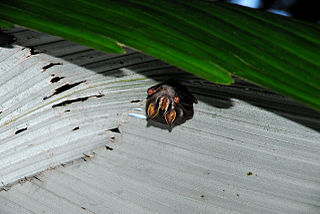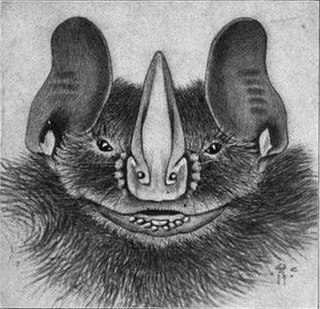
Megabats constitute the family Pteropodidae of the order Chiroptera (bats). They are also called fruit bats, Old World fruit bats, or—especially the genera Acerodon and Pteropus—flying foxes. They are the only member of the superfamily Pteropodoidea, which is one of two superfamilies in the suborder Yinpterochiroptera. Internal divisions of Pteropodidae have varied since subfamilies were first proposed in 1917. From three subfamilies in the 1917 classification, six are now recognized, along with various tribes. As of 2018, 197 species of megabat had been described.

The New World leaf-nosed bats (Phyllostomidae) are found from southern North America to South America, specifically from the Southwest United States to northern Argentina. They are ecologically the most varied and diverse family within the order Chiroptera. Most species are insectivorous, but the phyllostomid bats include within their number true predatory species and frugivores. For example, the spectral bat, the largest bat in the Americas, eats vertebrate prey, including small, dove-sized birds. Members of this family have evolved to use food groups such as fruit, nectar, pollen, insects, frogs, other bats, and small vertebrates, and in the case of the vampire bats, even blood.

The Jamaican, common or Mexican fruit bat is a fruit-eating bat native to Mexico, through Central America to northwestern South America, as well as the Greater and many of the Lesser Antilles. It is also an uncommon resident of the Southern Bahamas. Populations east of the Andes in South America are now usually regarded a separate species, the flat-faced fruit-eating bat. The distinctive features of the Jamaican fruit bat include the absence of an external tail and a minimal, U-shaped interfemoral membrane.

The Egyptian fruit bat or Egyptian rousette is a species of megabat that is found in Africa, the Middle East, the Mediterranean, and the Indian subcontinent. It is one of three Rousettus species with an African-Malagasy range, though the only species of its genus found on continental Africa. The common ancestor of the three species colonized the region in the late Pliocene or early Pleistocene. The species is traditionally divided into six subspecies. It is considered a medium-sized megabat, with adults weighing 80–170 g (2.8–6.0 oz) and possessing wingspans of approximately 60 cm (24 in). Individuals are dark brown or grayish brown, with their undersides paler than their backs.

Andersen's fruit-eating bat is a bat species from South America. It is found in Bolivia, Brazil, Colombia, Ecuador, French Guiana, and Peru.

Gervais's fruit-eating bat is a bat species from South America. It is found in Brazil, French Guiana, Guyana, eastern Peru, Suriname and eastern Venezuela.

The silver fruit-eating bat is a South American bat species of the family Phyllostomidae.

The gnome fruit-eating bat is a bat species from South America. It is found in Bolivia, Brazil, Colombia, Ecuador, French Guiana, Guyana, Peru, Suriname and Venezuela. This species was originally discovered to be different from the other known species of fruit bats, but later, in 1994 were mistakenly grouped under Artibeus cinereus as a synonym. However, this has since been corrected by more closely studying their physical differences and by biomolecular analysis.

The pygmy fruit-eating bat is a bat of the family Phyllostomidae. The specific name phaeotis is of Greek derivation, coming from the word phaios meaning dusky, referring to their dusky gray coloration.

The Neotropical fruit bats (Artibeus) are a genus of bats within the subfamily Stenodermatinae. The genus consists of 12 species, which are native to Central and South America, as well as parts of the Caribbean.

The Honduran fruit-eating bat is a species of bat in the family Phyllostomidae. It is found in El Salvador, Honduras, and Nicaragua.

The Toltec fruit-eating bat is a species of bat in the family Phyllostomidae. It is also sometimes called the "lowland fruit eating bat."

Brachyphylla is a genus of leaf-nosed bats in the family Phyllostomidae. Both species live on islands near or in the Caribbean. The genus contains the following species:

Stenodermatinae is a large subfamily of bats in the family Phyllostomidae.
Thomas's fruit-eating bat, sometimes also popularly called Watson's fruit-eating bat, is a species of bat in the family Phyllostomidae. It is found in southern Mexico, Belize, Guatemala, Honduras, Nicaragua, Costa Rica, Panama and Colombia. Its South American range is to the west of the Andes. The species name is in honor of H. J. Watson, a plantation owner in western Panama who used to send specimens to the British Natural History Museum, where Oldfield Thomas would often describe them.
Rosenberg's fruit-eating bat is a species of bat in the family Phyllostomidae. It is found in humid tropical forests in the El Chocó region on the coast of western Colombia and northwestern Ecuador at altitudes below 500 m. Until recently it was included within D. glauca, a canopy frugivore that also eats insects. It was elevated to full species status in 2009. The specific name is in honor of collector W. F. H. Rosenberg. The species is regarded as common, but is likely threatened by the deforestation of its habitat.

Bats are eaten by people in parts of some Asian, African, Pacific Rim countries and cultures, including Vietnam, Seychelles, Philippines, Indonesia, Palau, Thailand, China, and Guam. Half the megabat species are hunted for food but only eight percent of the insectivorous bat species. In Guam, Mariana fruit bats are considered a delicacy.
The Bogota fruit-eating bat is a species of bat found in South America.
Dermanura rava is a species of leaf-nosed bat found in Central and South America.













